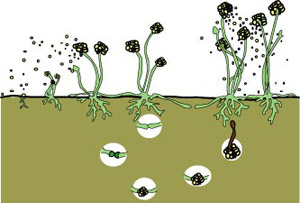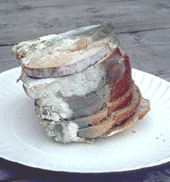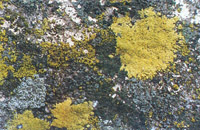 username@email.com
username@email.com
In this lesson, you will review the characteristics and types of fungi.
Members of the Kingdom Fungi are mostly coenocytic or multicellular organisms that are made up of masses of filaments, or hyphae (singular hypha), though some, such as yeasts, are unicellular. Collectively, all the hyphae of one fungal organism are called a mycelium, which makes up the main body of the fungus. Mycelium grows from the tip of the hyphae, and may reach a length of one kilometer in only 24 hours. The above-ground part of fungi that most people are aware of—mushrooms—are simply hyphae that are compacted and “packaged” to form the spore-producing fruiting bodies of the otherwise hidden organism. Curiously, the cell walls of fungi contain chitin, the same material that makes up insect exoskeletons, and not the cellulose that stiffens plant cells. Some fungi are parasites that feed directly from the host. Most fungi are characterized by their unique heterotrophy. Fungi release digestive enzymes onto something edible in surrounding substrate. The enzymes dissolve some of the nutritional material in the food, and the fungus absorbs these molecules. Fungi, with bacteria, are the primary decomposers of organic material.

Sporangia
Fungi are famous for producing spores, and they may reproduce both sexually and asexually, the latter being the spore-producing stage. Spores are produced asexually in structures called sporangia, and they are held in specialized hyphae called sporangiophores. Fungal spores have a tough coat that allows them to survive until they find a suitable environment in which to grow. Fungi may also reproduce asexually through fragmentation of the mycelium, with each bit developing into a new organism.
Sexual reproduction in fungi occurs when some hyphae produce a structure called a gametangium. Gametes may be fused in the gametangium and then released, or two gametangia may fuse to form a kind of fertilized egg.
The Kingdom Fungi is comprised of five major Divisions, each characterized by the structure and the mainly sexual reproductive pattern of its members. The members of a sixth Division, Deuteromycota, or Imperfect Fungi, do not reproduce sexually.
Division Chytridiomycota, the chytrids, is likely the most ancient group of fungi. Most are small, produce little mycelium, and anchor themselves to a substrate via rhizoids, which absorb nutrients. Rhizoids resemble hyphae but contain no nuclei. The chytrid sporangium contains numerous nuclei, and during reproduction each separates into a flagellated spore. Chytrids are the only fungi with flagellated gametes. Chytrids occur in both salt and fresh water, as well as in damp soil. They may also live parasitically on algae, plants, or other fungi.
Division Oomycota contains species that, as its name suggests, produce eggs (as well as sperm) during a sexual reproductive phase. Eggs and sperm are borne on separate gametangia and fuse to form zygotes. Oomycetes also reproduce asexually with spores that have two flagella. Most oomycetes are aquatic, but some species are terrestrial. Oomycetes have unique cell walls for fungi because they are made up mainly of cellulose, not chitin. Nearly all oomycetes live on decaying organic matter. Some are parasitic and others pathogenic—most notably Phytophthora infestans, the fungus responsible for killing the potatoes that led to the Irish potato famine.

Bread Mold
Fungi in the Division Zygomycota are all terrestrial, living mainly in soil, where they consume dead organic material. Some members of this Division are parasites or pathogens that infect mainly plants, insects, or tiny soil fauna. Zygomycete spores have no flagella. Sexual reproduction occurs when two different mating hyphae fuse, forming gametangia, which themselves fuse to form a multinucleated zygospore.
A common, though unwelcome, member of this Division is black bread mold, Rhizopus stolonifer. This mold has rhizoids that anchor it to bread or fruit and whose hyphae worm their way through and rot it.

Yeasts are small, oval, unicellular ascomycetes noted for their asexual reproduction through budding. Sexual reproduction may also occur when two yeast cells, or ascospores, join to form a zygote.
Many ascomycetes are parasites on plants; deadly ergot disease comes from fungal activity on rye grain.
Division Basidiomycota includes the familiar edible mushrooms. A mushroom is the basidiocarp, a spore-producing structure composed of compacted hyphae, of basidiomycetes. The body of basidiomycetes is the mycelium growing invisibly on a nutritional substrate, such as soil or a tree trunk. A single basidiomycete mycelium may grow to an astonishing 35 meters in diameter, though mushrooms usually form only around its edges. This accounts for the fairy rings of mushrooms that appear in a field after a good rainfall. The moisture triggers the production of new protoplasm in the mycelium, and the protoplasm forms hyphae that burst out of the ground as mushrooms. Sexual reproduction involves meiosis and fusion of haploid nuclei, which occurs externally in specialized hyphae called the basidium, where the spores form.
This Division is home to the most common and popular edible field mushroom (Agaricus campestris), as well as to numerous types of poisonous mushrooms, notably Amanita. Psilocybe mexicana, a hallucinogenic mushroom, is also in this group. These are all gill fungi, so called because gill-like slots under the mushroom cap hold their spores.

Lichens
Ascomycetes are the fungi almost always associated with green algae or cyanophytes to form lichens. Lichens thrive in harsh, adverse environments, such as deserts or tundra. Lichens do not need an external source of food, as their photosynthetic component provides it for them, though the fungus part of the lichen may derive certain minerals from the substrate to which it is attached. There are about 25,000 different types of lichens, each characterized by the species of fungus it contains. About 26 genera of photosynthetic algae or cyanobacteria live symbiotically in lichens with their fungus partner.
The Division Deuteromycota contains the Imperfect Fungi that cannot reproduce sexually. Many fungi in this Division are pathogenic parasites of plants or animals. In humans, ringworm and athlete’s foot are infections caused by these fungi. Deuteromycetes are not all bad, however; some are instrumental in making Roquefort and Camembert cheeses, as well as in the production of penicillin.
Mycorrhizae are symbiotic relationships between a fungus and the roots of vascular plants. The fungi help the plant roots absorb nutrients, particularly phosphorus. The plant roots supply the fungi with food, usually sugars or amino acids. About 90 percent of vascular plants have endomycorrhizae, or fungal hyphae in their root cells. Research has found that many vascular plants cannot survive apart from this intimate relationship with fungi.
The main body of a fungus is the
The correct answer is D. The mycelium is the body of a fungus made up of all the hyphae. Hyphae are the filaments that make up the body of the fungus, or mycelium, so A is not correct. The sporangium is the structure in which spores are produced, so B is incorrect. A basidium is a structure unique to basidiomycetes where the fungus’ spores are produced. Thus, C is not correct.
Members of the Division Deuteromycota are called Imperfect Fungi because
The correct answer is B. Deuteromycetes do not have the ability to reproduce sexually, unlike other fungi. Deuteromycetes do produce spores, so A is not correct. It is mainly ascomycetes that exist symbiotically with algae or cyanophytes as lichens, so C is incorrect. Some deuteromycetes are parasitic, but others, such as those used to produce cheese, are not; so D is not correct.
Gill fungi release spores from which structure?
The correct answer is C. Among the gill fungi in the Division Basidiomycota, spores are released from the gill-like furrows under the cap of the mushroom, or fruiting body. The gametangium is not part of the mycelium but is a specialized structure produced by hyphae for the purpose of sexual reproduction; so A is not correct. B is not correct because it refers to the site where mushrooms emerge onto the surface from the mycelium below ground. Rhizoids anchor mycelium to the substrate but do not release spores, so D is not correct.
Lichens are organisms in which ascomycetes fungi live symbiotically with
The correct answer is A. Lichens are algae or cyanophytes living symbiotically with ascomycetes fungi. Mycorrhizae are fungi that live on or in the roots of vascular plants, so B is not correct. Spores are the mode of reproduction in fungi and do not involve any symbiotic relationship with other organisms, so C is incorrect. Ergot is a disease of rye grain caused by one type of ascomycetes, so D is not correct.